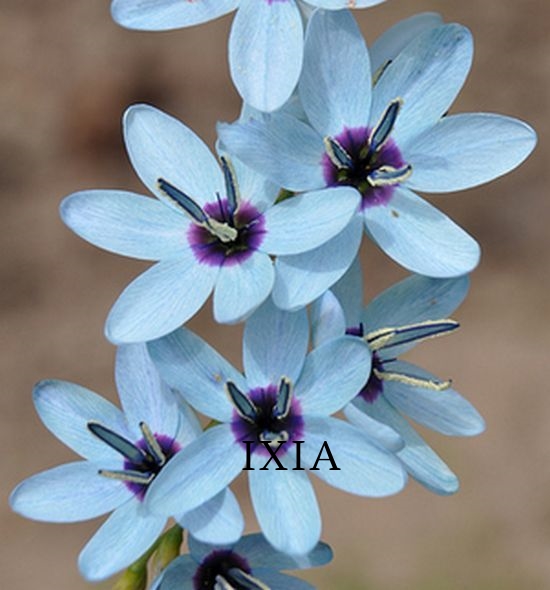We stock specialist seed of Primula sp., Ixia viridiflora and two new Digitalis varieties. Please scroll down to learn more about this range, or click on an image below to visit the product pages.
PRIMULA
We are proud to be able to offer seeds of the following choice strains of Primula sourced directly from specialist breeders. A packet of approximately 25 seeds should yield 20 good plants.
Primula Cultivation
Sowing
Primula seeds can be sown from late summer through to early autumn and again in late winter or early spring. It is best to use a peat based seed sowing compost in small pots or seed trays and sow the seeds thinly on the surface either leaving them uncovered or covering lightly with vermiculite. Moisten (but do not over-water) the compost and then cover the tray or pot with polythene or a small piece of glass to prevent drying out. Temperatures should not be allowed to exceed 20°C as this will inhibit germination. Primula seed normally germinates in about three weeks.
Transplanting
When the Primula seedlings are large enough, prick out into individual small pots and grow on for a further four to five weeks, by which time the plants should be ready to be moved into 9 cm pots. Primulas need an acid compost for best results, and an open texture is desirable to prevent waterlogging. Once the plants are growing strongly, feeding with a standard tomato fertilizer will help build strong healthy plants.
Planting out
After about eight to ten weeks in the 9 cm pots the young Primula plants will be ready for potting on or moving into the garden. If planting out make sure the soil has a reasonable humus content and if in doubt dig in some well rotted organic matter before planting. It is best to choose a moist (not wet or boggy) and partially shaded area to get the most out of your Primulas but they will survive in full sun if moisture is freely available. These plants will thrive for at least three or four years but after that it may be worthwhile invigorating the stock by sowing fresh seeds or dividing the plants in the garden by lifting them and splitting the crowns into three or four small pieces. Division of Primulas is best done in early autumn, say September, and should never be attempted during hot dry spells.
Pests and Diseases
Although Primulas thrive in cool moist conditions, good air movement is important to keep disease at bay. In the garden slugs and snails can be a problem as the pests like the same conditions as Primulas, so suitable control measures should be taken
IXIA VIRIDIFLORA
Ixia viridiflora is unlike anything else you can grow - long arching spikes of exquisite jade green or turquoise flowers carried on thin wiry stems which move in the lightest breeze but which will withstand any normal weather without damage. It is easy to grow Ixia viridiflora from seed, with flowers being produced after only 8 months. These are very attractive, but do not reveal the full potential of the species. In subsequent years the corms will produce more robust plants and larger flower spikes which can reach 2′ to 3′ in height.
Variation
As with any wild species, Ixia viridiflora shows a certain amount of variation between individuals. We eliminate any poor coloured forms, and cross pollinate those with the longest spikes and the largest flowers to constantly improve our stock. Ours may be the only Ixia viridiflora breeding program in the world.
Cultivation
In its native habitat, Ixia viridiflora grows over winter and flowers in late spring. It will do the same if sown or planted in the autumn in a cold glasshouse in the UK, or may be planted in the spring to give a later display. Given well drained sandy soil and a sheltered situation, Ixia viridiflora will often overwinter successfully in the garden in the UK. Generally speaking, where Gladioli will survive overwinter, so will Ixia viridiflora. A warm dry summer rest will ripen the corms ready for starting into growth again in the autumn.
The position of your Ixia plants should be clearly marked as the long, narrow leaves can easily be mistaken for grass.
FOXGLOVE
Owls Acre Seeds is currently carrying two interspecific hybrid varieties of Digitalis; Digitalis x martina and Digitalis x lucas. Both have been bred in the Netherlands by Maarten van der Saar. As sterile hybrids, these foxgloves will flower profusely for a prolonged period and at least two to three weeks longer than the more familiar and wild varieties, and as they do not seed, will not multiply unpredictably in subsequent years. These varieties are notable for their branching habits, making them ideal for container and landscape applications. Martina carries pink flowers and is the taller of the two, reaching about 1m (3ft) in height. Lucas has purple flowers, is shorter at around 70cm (28in) and is particularly well branched.
Martina and Lucas have similar hardiness to D. purpurea and can be grown in zones 5-9, doing best in partially shaded locations. They are true biennials and should be sown in the autumn (September/October) for flowers in April/May the following year.



